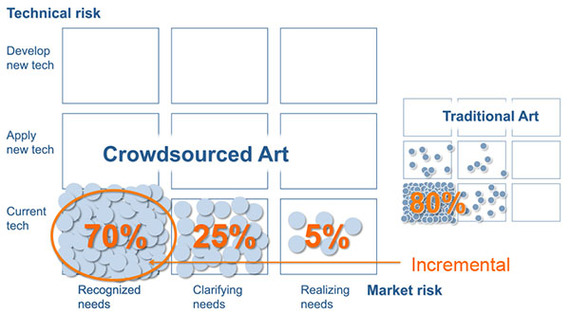Who might be more likely to dream up breakthrough ideas, the lone genius or a smart individual imbedded in a diverse social network? Western culture assigns ideas to individuals and we have patents to protect private ownership, however, is this way of thinking still best for the advancement of society?
By nature, all new designs are a recombination of already existing elements. Most designs address recognized needs and consist of combining commonly accepted elements. Novel designs that clarify needs are the unexpected combinations of elements, while the realized needs of paradigm-shifting designs are re-combination of elements requiring a different mental model or perspective to create or understand.
The act of synthesizing creative concepts usually requires that the creative professional arrange for a period of immersive research followed by alone time, to identify promising elements and experiment with a recombination of these elements. In the process, the creative formulates or invents a new meaning and builds a visual story. The creative professional might leverage cultural meaning, as well as, visual references that are from similar or completely different domains. One example might be transferring the design element of fighter jet wings onto cars.
When it comes to open crowdsourcing, however, the creatives do not just have existing elements and meanings available; they can also tap into designs from fellow participants. As designs are submitted and made public, the creative can follow the flow of designs and be inspired by elements, meanings and stories as they emerge. The open crowdsourcing process enables the individual to judge their performance and position themselves according to the submitted contributions. Does this mean that open crowdsourcing can assist in propelling innovation?
In 2013, a team of creatives in Johannesburg, South Africa, launched a crowdsourcing challenge, inviting designers across the world to submit posters to celebrate Nelson Mandela's ninety-fifth birthday. Approximately eight hundred posters were submitted and from these ninety-five were selected to become part of a traveling exhibit. The project offered a unique opportunity to assess open crowdsourcing performance and answer questions, such as: Does open crowdsourcing produce more breakthrough designs?
Comparing the innovativeness of the Mandela Poster project with art observed at 2015 L.A Art Show, those crowd-sourced posters were significantly more innovative along market risk in that they were more likely to identify and realize art containing new meaning. However, due to the restrictions of the poster contest, no innovativeness was observed along technology risk, meaning they all had applied traditional poster technology.
These findings are surprising, since one would expect the restriction of a poster contest to produce less innovative solutions and "blue sky" no limit art to produce more innovative solutions. The explanation may be that the interaction, inspiration and very immediate competition with others provided a constant reminder and feedback, spurring the poster artists on and, thus, they strived to excel. The transparent open nature of crowdsourcing helped them to know where their ideas were in comparison to their competitors, making them strive to be selected.
Another equally plausible explanation may simply be that the inspirational assignment of celebrating Nelson Mandela's birthday caused them to stretch. As work with inspirational design briefs has shown, inspiring designers makes for more innovative solutions. In turn, these innovative solutions help to advance society and keep inspiration alive.
Special thanks to Kelo Kubu for help researching this article
